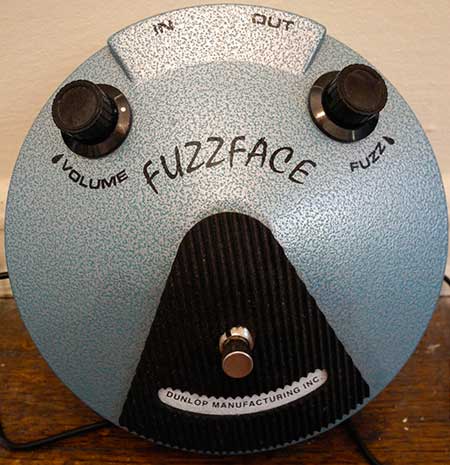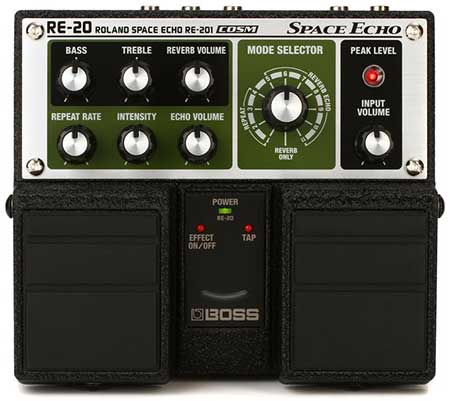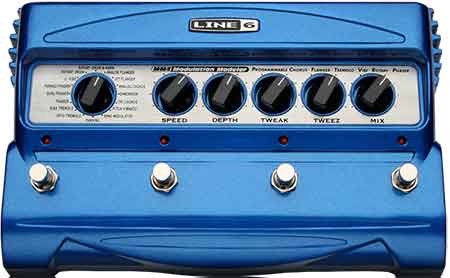Learning to play classic rock on the guitar is not just about the licks, but the sound and tone. If you can’t capture the sound, it will always feel as though something is missing no matter how much you nailed the solo for “Hotel California”. Some of the best tools one can have are good effects pedals. The pedals help you to shape the sound of your rig and make it more versatile.
The guitar and the amp are the foundation, so those are the top two things to spend your hard-earned money on before getting too crazy with effects. Once you have a decent rig, the pedals will then augment your sound and give you many more tonal options.
The other piece of gear that is important to consider – and I say it’s the most important piece of gear of all – is your hands. Much of the tone-chasing can be avoided by simply concentrating on your playing mechanics. The way your fingers fret the notes, the attack of your pick, the particular way you grip the neck, the aggressiveness of your vibrato. All of these things shape your tone in ways that pedals or amps simply cannot.
Classic rock is one of those genres that guitar players of all walks of life find themselves diving into at one point or another. It was the golden age of the electric guitar and the songs from that era have some of the most memorable and iconic guitar riffs and solos of all time. Not only that, but they are also incredibly fun to play. Nailing the riffs is one thing, but getting the tone has to be just as, if not more satisfying.
This is where effects pedals come in. I’m specifically talking pedals here, but effects come in other forms such as rack units as one would find in a studio, multi-effects processors, and software plugins. Effects pedals, a.k.a. “Stompboxes” were more widely used in the age of classic rock. A few effects on the floor are easier to access and it keeps things simple.
In the spirit of keeping things simple, let’s take a look at five of the most essential guitar pedals for classic rock:
- Overdrive
- Wah-Wah
- Distortion (Fuzz)
- Delay
- Modulation
Narrowing things down to these five effects type is only the first step. The next step is determining which pedals will do the job. If classic rock is the direction you are headed, then there is good news. There are a handful of pedals that were widely in use when classic rock was not yet “classic” that are still in use today. They have stood the test of time and this makes the shopping relatively easy.
I will caution you to avoid the temptation of too much window shopping with boutique and experimental pedals. Those are fun, but wait until you develop your ear for the effects a little more before venturing out into that space.
Here’s the list of the five essential guitar pedals for classic rock, along with a modern “runner up” that does a great job capturing the essence of the tried and true stompboxes.
1. Overdrive: Ibanez Tube Screamer (TS808)
There are two main versions of the Tube Screamer; the TS808 and the TS9. The TS808 was the original that came out in 1970, whereas the TS9 was a more modern release in the mid-80s. Your classic rock sound will benefit more from the TS808 as it is a smoother, warmer sound. The TS9 is a little more biting and rough around the edges.
The TS808 comes in around $180 and the TS9 is more like $100, but classic rock enthusiasts will more often than not insist that the extra $80 is worth it for the tone. I tend to agree as I find the TS9 to be a little too harsh. It works for certain sounds of 80s rock, but I would still prefer the TS808.
Runner-Up: Fulltone OCD

I’ve mentioned this pedal in other writings and there’s a reason. It’s just a great pedal. For classic rock, it can do the job. It doesn’t quite capture the authenticity of the Tube Screamer, but it can be shaped in such a way that you can get by just fine and still have something in your rig for a more modern sound when you want to switch things up.
When using this pedal for classic rock, keep the drive dialed back and keep the switch on “LP” for Low Peak which is a clean boost. In other words, this setting will just give your sound a boost without changing any of the characteristics of your amp settings. The “HP” is High Peak and it boosts the mid-range as well as the gain level for a more modern, saturated sound.
The Fulltone OCD can be bought new for less than $130.
2. Wah-Wah: Dunlop Crybaby
Every classic rock guitar player needs a good Wah-Wah. Everyone back in the day had a Crybaby including Jimi Hendrix, Eric Clapton, David Gilmour, Stevie Ray Vaughn, and Slash. Many iconic guitar players now have their own signature line, but it all started here with the original Crybaby. Simple, elegant, and inexpensive at $80, the crybaby is a mini tank with a durable metal chassis and has a great response to the foot.
Runner-Up: Dunlop JB95 Joe Bonamassa Signature Wah
Just like it’s namesake, this has a classic sound with a modern twist. The main differences here from the original are a wider range, or “sweep”, and a Halo inductor which adds more of the harmonic overtones that a wah pedal typically produces. It is much more exaggerated and expressive. For playing most classic rock, this can be used, it should just be used “responsibly”.
These are a little more expensive than the standard Crybaby at $170.
3. Fuzz: Dunlop Jimi Hendrix Fuzz Face

What Hendrix fan would go without a Fuzz? There have been a lot of variations of this pedal, but the more faithful re-creation of this classic is probably the JHF1 for $150. The fuzz pedal is a classic distortion pedal with a warm, dark sound that can only be described as… well… fuzzy.
Distortion back in the day wasn’t the animal that it is today. These days, you can get distortions in a lot of different flavors, many of which can shave the hair off a squirrel. When getting a distortion for classic rock, fuzz is the way to go.
Runner Up: Electro-Harmonix Ram’s Head

This is a modern reissue of the 1973 Violet Ram’s Head. Compared to the older fuzz pedals, this one has more sustain and more clarity and is more characteristic of a standard distortion pedal. Typically, the point of the fuzz is to lose clarity, but this is a good option if you are looking for something that gives you more versatility when going from classic to more modern sounds. Just play around with the “Tone” knob when switching styles. At $100, it’s a good buy.
4. Delay: Boss RE-20 Space Echo

To get a true classic, original delay effect is an expensive endeavor. The Roland 201 Space Echo was a delay and reverb processor that came out in 1974. If you want to get one of the original style units, it will run you somewhere around $2,000. Your best bet as a guitar player is to go with the digital version that Roland’s guitar effects company, Boss, introduced in 2010. It’s much more affordable at a little over $200.
Delay and reverb really help the guitar take up more space sonically speaking, especially when reproducing guitar parts from three- or four-piece bands where there aren’t a lot of other ambient type instruments. Spring reverb and slap-back delay are great for classic blues as well. Fast-forward to the late 80s, you can really get into delay effects if you are going after the sounds created by U2’s Edge.
Runner-Up: MXR Carbon Copy Analog Delay

Classic sounding delay for the modern guitar player. That’s probably the best way to describe this pedal. This is a simple analog delay that is a great option to add some depth to your sound. The analog delay is more of the classic sound as the delayed part is a lower resolution than that of a digital delay which is more of an exact copy of the note you just played, thus more clear and defined.
The “Mod” button is a modulation that adds a chorus effect to the delay which gives it more depth and saturation. That can be a good addition to the sound when going for some Hendrix or Pink Floyd sounds.
For $150 you can get the pedal and can usually get some cables thrown in there as well.
5. Modulation – Electro-Harmonix Good Vibes

Modulation refers to a group of effects rather than a single effect. It’s here you can decide for yourself which mod pedal you want to go with depending on your musical influences. The effects of Modulation range from flange, chorus, vibrato, and phasers. There are also “envelop filters” which are essentially wah-wah pedals on autopilot.
Just like delays, some of the original pieces of gear can get pricy, so I recommend something simple and versatile. The Good Vibes is available for less than $150 and gives you plenty of tonal options in the realm of chorus and vibrato. Check out this video to get an idea.
Runner-Up: Line 6 MM4

Okay, so this is a tricky one because it’s discontinued. You’ll have to do some hunting to find a used one, but this is a really cool pedal if you want to get more into modulation. It has a little bit of everything and does a great job at replicating the old sounds.
As with any Line 6 product, buyer beware. They are very secretive about their schematics, so if it breaks, it’s done. The chances of you finding someone to fix it up are slim to none. These days, this type of multi-effect is found in software or processors.
When in doubt about which type of modulation effect to get, stick with chorus!
A Word About Processors And Software
When it comes to replicating the sounds of classic rock, another option is in the technology of today. Multi-effects processors have been around for decades but were typically used in studios and on tour. They tend to be bulky and expensive. Today, processors such as the Helix are all the rage. They are a lot more affordable than they used to be, typically ranging from around $500 to $2000.
With all of the patches that are out there on the internet that are being shared by various communities, there is no end to the sounds and you can literally find any effect or combination effect you want for any kind of sound imaginable. However, there is a steep learning curve and the sheer amount of customization is enough to send a normal civilian to the Looney Bin.
The guitar players of the classic rock era kept things simple. The late 60s and early 70s guitarists had minimal effects and had them at their feet on the floor. There’s no need to go overboard with the effects. Stevie Ray almost never used effects. Jimi Hendrix would just have a couple/three at his toes.
Where The Real Tone Lies In Classic Rock
Pedals are wonderful toys. However, they must be viewed as tone augmenters rather than tone creators. Many effects that you hear from the classic rock guys may come from a pedal, but so much of it comes from the manipulation of their most basic pieces of gear – their guitar and amp.
Your guitar and amp are the best effects you have. Spend the majority of your time dialing in the guitar and the amp before adding pedals to the mix. You will be glad you did. The pedals will then just slide right into your rig and you will spend much less time trying to figure out how to adjust the pedal to suit your sound.


